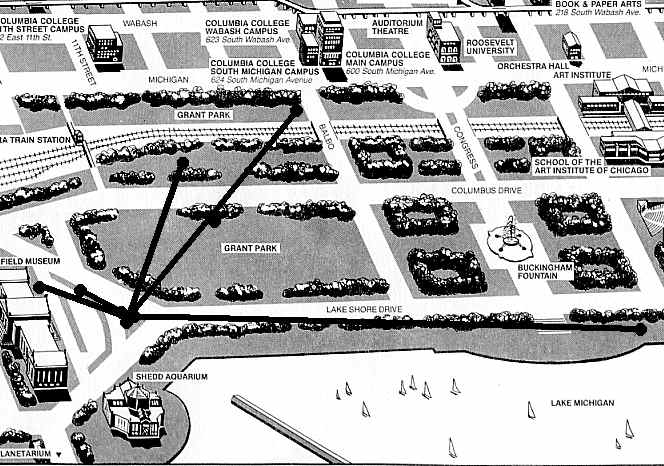
Originally this proposal was tendered to staff at the Planitarium in April of 1999, at the behest and urging of Mike Lash of the City of Chicago Department of Public Art. I met with Planetarium and Museum Campus officials in May. They loved it, or seemed to, but some changes were suggested, specifically to relocate the design to the causeway leading to the Planetarium, and the suggestion to not light up the planets, except the Sun. They promised maps.It might have worked out, but on a very tight schedule, for the causeway was under construction, only a month's lead time was allowed for, and the model making would fall mostly on me.
The maps never came, however. I waited two weeks; never heard from them. At that point I called Mike and him I was backing out. So much for a large scale model.
(4/28) This is a model of the solar system, accurate for January 1, 2000, representing the natal chart for the birth of a new millenium, scaled to about 3/4 mile.
The model consists almost entirely of "space," since the largest object, the Sun, would be only 5 1/2 inches in diameter. Planet sizes would vary from 1/2 inch to 1/16th inch.
A walking tour of this solar system will allow viewers to gain an appreciation of the isolation of our planet in the universe.
The actual sizes and distances are presented on the following table.
| object | diameter in miles | relative size | distance from sun in miles | distance from sun in AU's |
|---|---|---|---|---|
| Sun | 864,000 | 1000 | -- | -- |
| Mercury | 3,100 | 4 | 36,000,000 | 0.39 |
| Venus | 7,700 | 10 | 67,000,000 | 0.72 |
| Earth | 7,900 | 10 | 93,000,000 | 1 |
| Mars | 4,200 | 5 | 142,000,000 | 1.53 |
| Jupiter | 88,700 | 100 | 484,000,000 | 5.19 |
| Saturn | 72,000 | 80 | 887,000,000 | 9.53 |
| Uranus | 32,000 | 40 | 1,787,000,000 | 19.17 |
| Neptune | 31,000 | 40 | 2,797,000,000 | 32.19 |
| Pluto | 3,600 | 4 | 3,675,000,000 | 39.52 |
The nearest star is 269,280 AU's away.
The next galaxy is 126.7 billion AU's away.

This is a proposal to install a scale model of the Solar System, based on dimensions which would place Pluto at 2000 feet from the location of the Sun, a distance of 3/4 mile. This size was chosen as a suggested possibility.
A scale model at this dimension would call for a sun with a diameter of 5 1/2 inches. Jupiter and Saturn would be approximately 1/2 inch in diameter each; Earth, Venus, and Mars would be 1/16 inch in diameter approximately.
It is proposed that the Sun and planets be represented with lamps placed on pedestals, located at proper intervals, and on a two dimensional plan corresponding to some important date. I suggest that January 1, 2000, be used to locate the planets on a flat plane. Other dates within a hundred years will not vary the location of the far outer planets much.
The lamps would be on day and night. For the smaller planets 14 volt milli-watt lamps would be used. The four larger planets would use 14 volt automotive lamps. The sun would require a 500 to 1000 watt lamp, possibly contained in a opal glass sphere. A milli-watt lamp can easily be seen at 300 feet or more in daylight.
| SIZES OF THE PLANETS | |||
|---|---|---|---|
| object | diameter - miles | relative size | scaled size in inches |
| sun | 864,000 | 1,093 | 5.6424 |
| mercury | 3,100 | 3 | 0.0202 (0/16) |
| venus | 7,700 | 9 | 0.0503 (1/16) |
| earth | 7,900 | 10 | 0.0516 (1/16) |
| mars | 4,200 | 5 | 0.0274 (0/16) |
| jupiter | 88,700 | 112 | 0.5793 (9/16) |
| saturn | 72,000 | 91 | 0.4702 (8/16) |
| uranus | 32,000 | 40 | 0.2090 (3/16) |
| neptune | 31,000 | 39 | 0.2024 (3/16) |
| pluto | 3,600 | 4 | 0.0235 (0/16) |
| DISTANCES FROM SUN TO THE PLANETS | |||
|---|---|---|---|
| object | distance from sun miles | scaled distance, inches, and feet and inches | |
| mercury | 36,000,000 | 235 | 19 feet and 7 inches |
| venus | 67,000,000 | 438 | 36 feet and 6 inches |
| earth | 93,000,000 | 607 | 50 feet and 7 inches |
| mars | 142,000,000 | 927 | 77 feet and 3 inches |
| jupiter | 484,000,000 | 3161 | 263 feet and 5 inches |
| saturn | 887,000,000 | 5793 | 482 feet and 9 inches |
| uranus | 1,787,000,000 | 11670 | 972 feet and 6 inches |
| neptune | 2,797,000,000 | 18266 | 1,522 feet and 2 inches |
| pluto | 3,675,000,000 | 24000 | 2,000 feet and 0 inches |
| nearest star | 2,581 miles | ||
| nearest galaxy | 1.21 million miles | ||

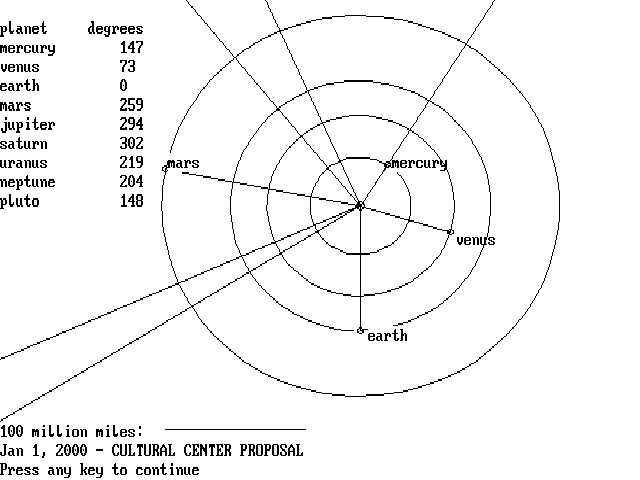
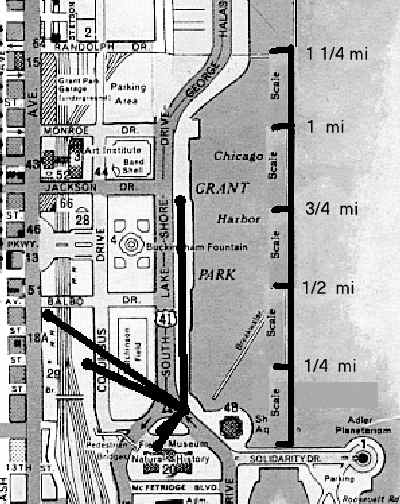
|
Pluto is located lakeside, east of the LSD, at Jackson
Drive.
Neptune is located just south of Balbo Drive, between Michigan Avenue and the ICG tracks. Uranus is located west of Columbus Drive and east of the ICG tracks, between Balbo and the Columbus to LSD cutover. The inner planets are located on the grass field north of the gully. Jupiter is located in the grass field north of the museum, south of the gully. Saturn is located near the northwest corner of the museum. |
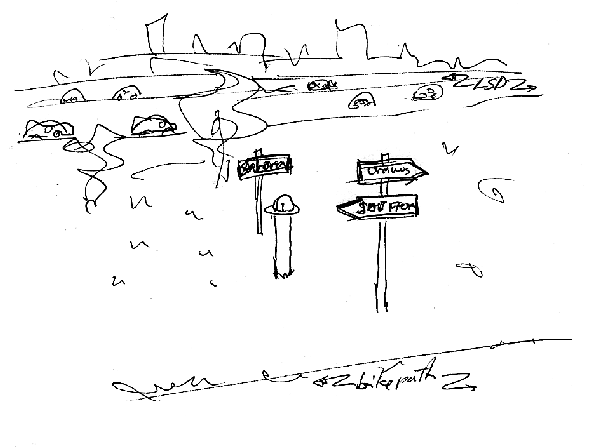
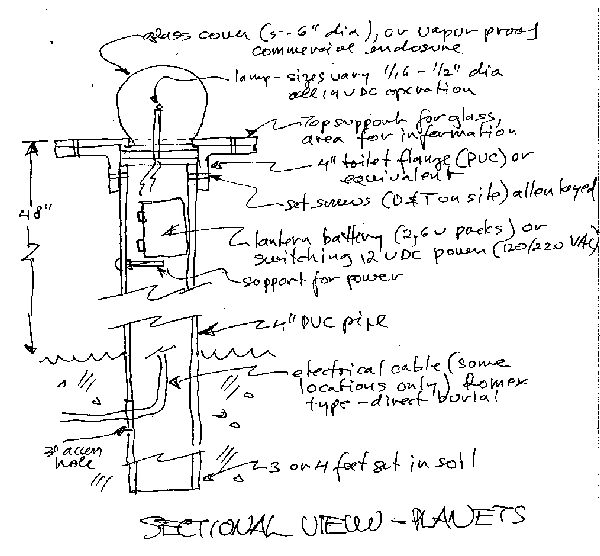
| quantity | description | p/u | total |
|---|---|---|---|
| lamp stands, parts list | |||
| 10 pc | 8 foot PVC pipe | $4.00 | $40.00 |
| 10 pc | PVC toilet flange | $8.00 | $80.00 |
| 9 pc | glass lamp cover -- Commercial vapor proof enclosure preferred. This increases the cost. | $3.00 | $27.00 |
| 1 pc | glass lamp cover (sun) | $12.00 | $12.00 |
| 1 pc | lamp for sun, 1000 watt | $18.00 | $18.00 |
| 2 pc | 1/4" lamp | $4.00 | $8.00 |
| 2 pc | 1/2" lamp | $4.00 | $8.00 |
| 5 pc | 1/16" lamp | $4.00 | $20.00 |
| lot | misc sockets, wiring, fasteners | $140.00 | |
| 10 pc | 6 volt lantern battery | $14.00 | $84.00 |
| 4 pc | 12 volt switching power supply | $40.00 | $160.00 |
| estimated base price, without contingencies | $594.00 | ||
Lamp bases, design, materials ..
The lamp bases are 4 inch diameter PVC piping, a strong waterproof material which is easy to work. Flanges are used at the top to support the lamp fixtures and glass covers. The PVC pipe is placed in the ground after a post hole is dug. Lamp bases placed on concrete can be fitted with lead anchors and a larger metal base plate.
$1000.00
field electrical services by others ..
The sun would have to be operated at 120 volt, and larger lamps operate from a 12 volt DC supply which is connected to a 120 VAC source. The inner planets could all be fed from a common 12 VDC source.
Cable to the lamp stands (12 VDC or 120 VAC) would be the direct burial type, placed in a grove made by a slitting machine. This would have to be done by either City, Park District, or Museum personel. The 120 VAC sources would have to be found at nearly locations, either available as 120 VAC ground level outlets, or taken as a feed from nearby lamp posts or other utilities.
$2000.00
field signing by others ..
Labels for each of the lamp stands and directions to other planet locations would have to be designed and placed by others. I can supply small circular labels for the lamp bases, but larger signing might be better designed and installed by museum personel.
$2000.00
field installation by others ..
Installation involves finding exact locations, digging post holes, placement and back filling, disposal of excess soil, and making the final electrical hookups. Although I could do all the installations (with proper access permissions), I am allowing for the possibility that City, Park District, or Museum forces may have to be used for this.
$1500.00
total ... $6500.00
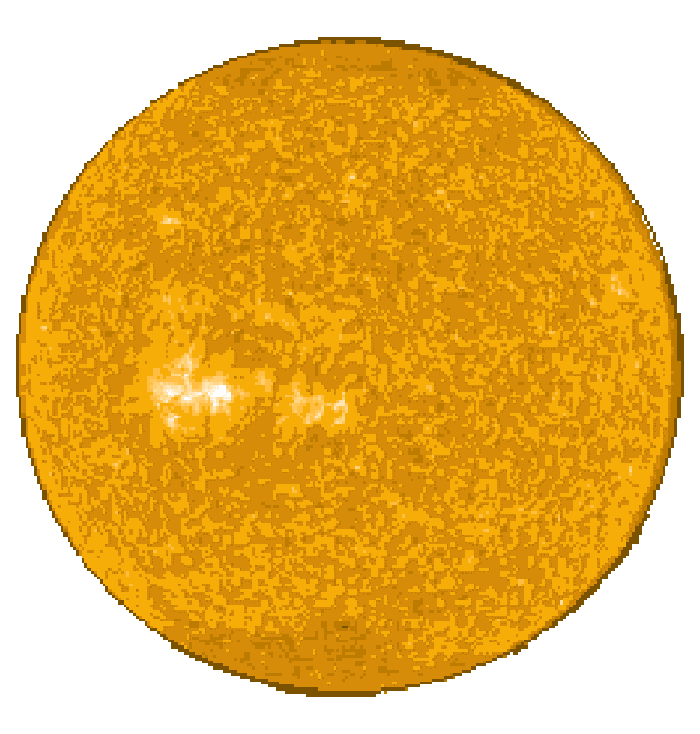
The Sun: A very large glob of dense burning gas. The Sun is 100 times the diameter of the earth, and slowly rotates about itself once a month. She wouldn't fit between Earth and its moon.

Mercury: Messenger god of the Greeks, and the angel of announcements of the Hebrews. About the size of our moon, Mercury is the Sun's "moon," always keeping the same face towards the Sun in its 88 day "month," like our moon does to us. The fastest moving planet.

Venus: Athena of some of the Greeks, and Venus of the Romans. Virtually the same size as the Earth, shrouded in dense clouds, and covered with active volcanoes, Venus is often the brightest object in the sky. Venus rotates backwards, that is, it is turned upside down. Galileo discovered that Venus had phases like our moon, with his 200 foot telescope. His mother-in-law could see that with her bare eyes.

Earth and Moon: Meaning soil or dirt in northern European languages, Ge of Geography, and related names, of the Greeks. 1/100th the size of the Sun, wrapped in a thin layer of clouds, and covered with water and some small land areas. Tilted at a precarious 23 degrees to the plane of its orbit about the Sun, it rotates once every 24 hours. A very large and distant satellite orbits Earth once every 27 days (29.5 days as seen from Earth) at a distance of some quarter million miles.

Mars: Ariz of the Hebrews, Marut of the Hindus, taken up by Greek and Roman mythology as Ares and Mars. Since antiquity Mars has had two dogs (named Fear and Terror) chasing about the legs his war horse. Two very close in and speedy satellites of Mars were discovered in 1877, and named accordingly. Mars is somewhat larger than our moon, is as badly tilted as the earth (25 degrees), and also rotates in 24 hours.

Jupiter: Jove Pater - father Jove - of the Romans, Zeus of the Greeks. The largest planet, 10 times the size of Earth, rotates in an incredible ten hours. Has more mass than all the other planets put together, and represents almost all the angular momentum of the solar system. For all practical purposes our solar system is a binary star system, with one dead star. Jupiter is brighter than any star, and easy to locate in the sky. Half a dozen of its satellites can be seen with binoculars. Moves one zodiac sign each year.
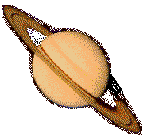
Saturn: The obscure Saturnus of the Romans, may have been Cronos of the Greeks - meaning either time keeper (which actually Jupiter accomplishes), or crowned, ie, ringed. Companion to Jupiter, almost the same size and rotational speed, but is mostly a ball of gas around a small core. Crowned with rings at the equator. Circuits the Sun in 30 years. The most distant planet known and tracked since antiquity. Father of Zeus.

Uranus: Somewhat less than half the size of Jupiter, and discovered in the 18th century, it takes 84 years to make a circuit around the Sun. Named after Father Sky of Greek creation myths (Hesiod), for he was banished by his son Cronos. Rotates at right angles to the plane of its orbit. Looks like it had an accident.

Neptune: After the Roman Neptune, another banished loser in the battle of the gods. About the same size as Uranus, but almost twice as far from the Sun.

Pluto: The Roman dog of Hell. Hardly a planet, Pluto is a little larger than our moon, and travels a tilted and wildly elliptical path which crosses the orbit of Neptune. Probably Neptune's moon at one time.
I have often been attracted to staging visual realizations of large numbers. The distances, the magnitudes, and the emptiness involved in our diminutive occupation of a small parcel in an outsweeping arm of a remote galaxy calls for a reduction of these dimensions to a physical model which, if it could be seen, might evolve in our minds some reasonable concepts about the relative magnitudes -- and their consequences.
The distances involved in our solar system are so large as to be virtually unimaginable. Stellar distances are 5 orders of magnitude larger yet. Simulations of space travel as seen in films are generally wildly inaccurate, but they are part of popular culture, part of how we view ourselves as "in control," even of galactic distances. Stars flit by on Star Trek, yet the stars would not noticeably move even at 1000 times the speed of light.
This cultural perception of space as conquerable and controllable results from the fact that planet sizes and interplanetary distances, and by extension the distances involved in the universe, cannot be properly imagined in our minds. Big numbers just remain meaningless big numbers.
The emptiness of space, the distances between planets, and the diminutive sizes of the planets in relationship to the sun, will remain meaningless unless they can be seen and experienced. This requires a very large scale mode -- small enough to see planet to planet distance, yet large enough so that the planet sizes do not disappear altogether from sight.
This installation was first accomplished for the South Bend Regional Museum of Art at an outdoor group exhibition at the Morris Civic Auditorium Plaza in South Bend, Indiana, on July 2 - 4, 1993.
The model in South Bend was 175 feet in its largest dimension. Milliwatt lamps were used for the planets, measuring 1/16 of an inch in diameter. Even so, all of the planets could be spotted at these distances, despite sunlight, competing street lights at night, and the busyness of trees, people, and automobiles.
A second model was exhibited at Beret International Gallery in April of 1997, reduced to some 39 feet. The inner planets here occupied a space only 18 inches in diameter; the outer planets were spotted throughout the remaining 40 feet. The model was staged 5 inches off the floor.
The text above is mostly lifted from the hand-out brochure "Walking Tour" presented at South Bend in 1993, and Copyright 1993 © the South Bend Regional Museum Of Art. Copyright 1993, 1997 © Jno Cook. Copyright 1997 © Beret International Gallery.
 Aesthetic Investigation
Aesthetic Investigation
Feel free to send [comments] via email.